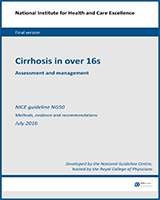NCBI Bookshelf. A service of the National Library of Medicine, National Institutes of Health.
National Guideline Centre (UK). Cirrhosis in Over 16s: Assessment and Management. London: National Institute for Health and Care Excellence (NICE); 2016 Jul. (NICE Guideline, No. 50.)
People admitted to hospital with liver disease in England in 2012 were more likely to die compared to people admitted with other conditions (8.8% compared to 1.4%). Nearly half of the liver-related hospital admissions were for people with alcohol-related liver injury and 12.3% of these admissions resulted in death. Men accounted for over two-thirds of admissions for alcohol-related liver disease (ALD).98 Finished admission episodes with a primary diagnosis of cirrhosis in English NHS hospitals rose from 3783 in 2005/06 to 5621 in 2014/15 (48.6% increase).99 Consequently, the Chief Medical Officer has identified liver disease as one of the key issues for population health in England because it is the only major cause of mortality and morbidity that is increasing.49
Cirrhosis is a condition that occurs as a response to liver damage. It is characterised by disruption of the normal liver architecture and its replacement by fibrous bands of tissue and nodules of regenerating liver tissue. Cirrhosis usually develops over a period of years following exposure to one or more risk factors such as alcohol misuse, hepatitis B or C and non-alcoholic fatty liver disease (NAFLD), which cause inflammation and cell death within the liver. However, not everyone who is at risk will eventually develop cirrhosis; thus, the proportion of individuals who develop cirrhosis who abuse alcohol or have chronic viral hepatitis is around 10–20%, whereas with NAFLD it is around 5–10%.235 Better recognition of individuals at risk of cirrhosis would allow for more timely intervention.
There is currently variation in practice across England and Wales for diagnostic tests for cirrhosis. Liver biopsy, performed in secondary care, has been the definitive diagnostic method for confirming cirrhosis but several non-invasive tests to predict cirrhosis have been developed, based on combining the results of routine laboratory liver blood tests, proprietary blood test panels that are surrogate markers of fibrogenesis, or imaging methods to measure the ‘stiffness’ of the liver. These tests can be performed in primary care or in an outpatient setting in secondary care; the results of the imaging tests are available immediately. Consequently, guidance is required to assess the clinical and cost-effectiveness, and patient acceptability of liver biopsy compared to the non-invasive tests of fibrosis in the confirmation of a diagnosis of cirrhosis.
People with cirrhosis may show no symptoms or signs of liver disease for many years and so do not come to attention until their disease progresses and they develop one or other of the major complications such as jaundice, fluid retention manifest as swelling of the abdomen and/or lower limbs, bleeding from their upper gastrointestinal tract or changes in their mental status. Thus, opportunities to intervene often come late. Presently there are no standard criteria for referral by primary care of a person with suspected cirrhosis for assessment in secondary care. Also there is a clear need for a cirrhosis risk assessment tool to assist in the identification of people who are at high risk of liver decompensation before they experience a defining event. Such a tool would inform the timing of referral of a person with compensated cirrhosis to specialist hepatology services for further assessment including suitability for liver transplantation.
This guideline provides advice on the assessment and management of people aged 16 years or older who are suspected or confirmed to have cirrhosis for clinicians in primary and secondary NHS-commissioned care. The aetiologies of cirrhosis in children and young people are generally different to those in adults (for example, biliary atresia), and the assessment and management of these conditions is different. However, the recommendations in this guideline may be useful to clinicians who are caring for young people in transition. The guideline sets out the critical pathways in the management of complications of cirrhosis and provides advice when to offer surveillance testing for the detection of hepatocellular carcinoma and oesophageal varices. It also gives recommendations for the prophylactic treatment of oesophageal varices to prevent variceal haemorrhage and the use of antibiotics for the primary prevention of spontaneous bacterial peritonitis. These recommendations establish the concepts that effort in the management of patients with confirmed cirrhosis should be directed either to the prevention of complications or early intervention to stabilise disease progression in order to avoid or delay clinical decompensation and the need for liver transplantation. The recommendations in this guideline will facilitate the generation of a set of quality indicators for measurement of quality of care in people with cirrhosis.
- Introduction - Cirrhosis in Over 16sIntroduction - Cirrhosis in Over 16s
Your browsing activity is empty.
Activity recording is turned off.
See more...
